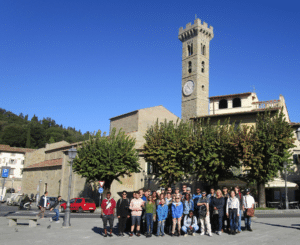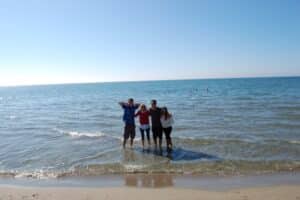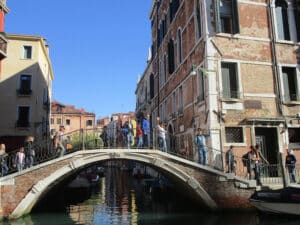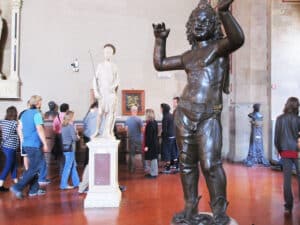
On October 13, we were back in Florence for a visit to the Cathedrale Santa Maria del Fiore, with its famous Duomo, Bapistry and Bell Tower. After touring the museum — including the ancient ruins in the crypt over which the cathedral was built — we climbed to the top of the Duomo for another spectacular view of Florence, this time from within the city.
No matter how many times we view these iconic symbols of Florence, they still take our breath away by their sheer grandeur, majesty and beauty.
Construction on the Cathedrale was started in the 13th century and the dome, designed by Filippo Brunelleschi, was added in the 15th century. It is an engineering marvel. We saw wooden models of the design along with the tools used in its construction in the museum. It is astonishing how such massive, ornate and beautiful structures were completed with no modern tools or technology and yet have survived for centuries. We also saw the original doors and statues which have been removed to preserve them in a controlled climate and replaced by copies on the exterior. The climb to the top of the Duomo was an arduous one — 460 steps up a steep, winding and narrow passageway to the top. The panoramic view of Florence and the surrounding countryside was truly worth every step. Some of the students opted to climb the Bell Tower, as well, to get another perspective.

On Oct 20 we traveled by public bus to Fiesole. The significance for us is that it figures heavily in the E.M. Forster’s book, A Room With A View, which we are studying in our European Literature class. Fiesole has always been an affluent community high above Florence. Starting in the 14th century the wealthy built villas there to escape the heat and noise of the city, and it remains one of the most affluent communities in Tuscany. It is, however, an ancient Etruscan site, later a Roman city where students of augury were sent to learn the craft of divination. There is a lovely church and former Franciscan Monastery at the top of one of the steep hills with a small museum housing an amazing collection of artifacts from the near and far East brought back by missionaries. It was another arduous climb and worth every step.

On October 27 we returned to Florence to visit two more important, historic sites. The Palazzo del Bargello is a former prison and the site of false incarceration, torture and execution. Thankfully, for us, it is now an important art museum. The building was constructed during the 13th century and was originally where a Florentine magistrate lived. It is a proper castle with open interior courtyard with staircases leading to the upper floors where there are works by Michelangelo, Ghiberti, della Robbia, Donatello and may others.

Our next adventure will be Rome. We will spend four days there and hope to visit some of the most iconic sites in the city. In the meantime, classes are going well – we have passed the midterm point and the students continue to develop their observation skills through painting, photography, journal-keeping and blogging. They are honing their communication, analysis and comprehension skills in their literature and professional writing classes.
Many parents will be visiting over the Thanksgiving holiday week and we will be eager to share with them our adventures (so far) in person.
Ciao for now.
-Andrea Brode